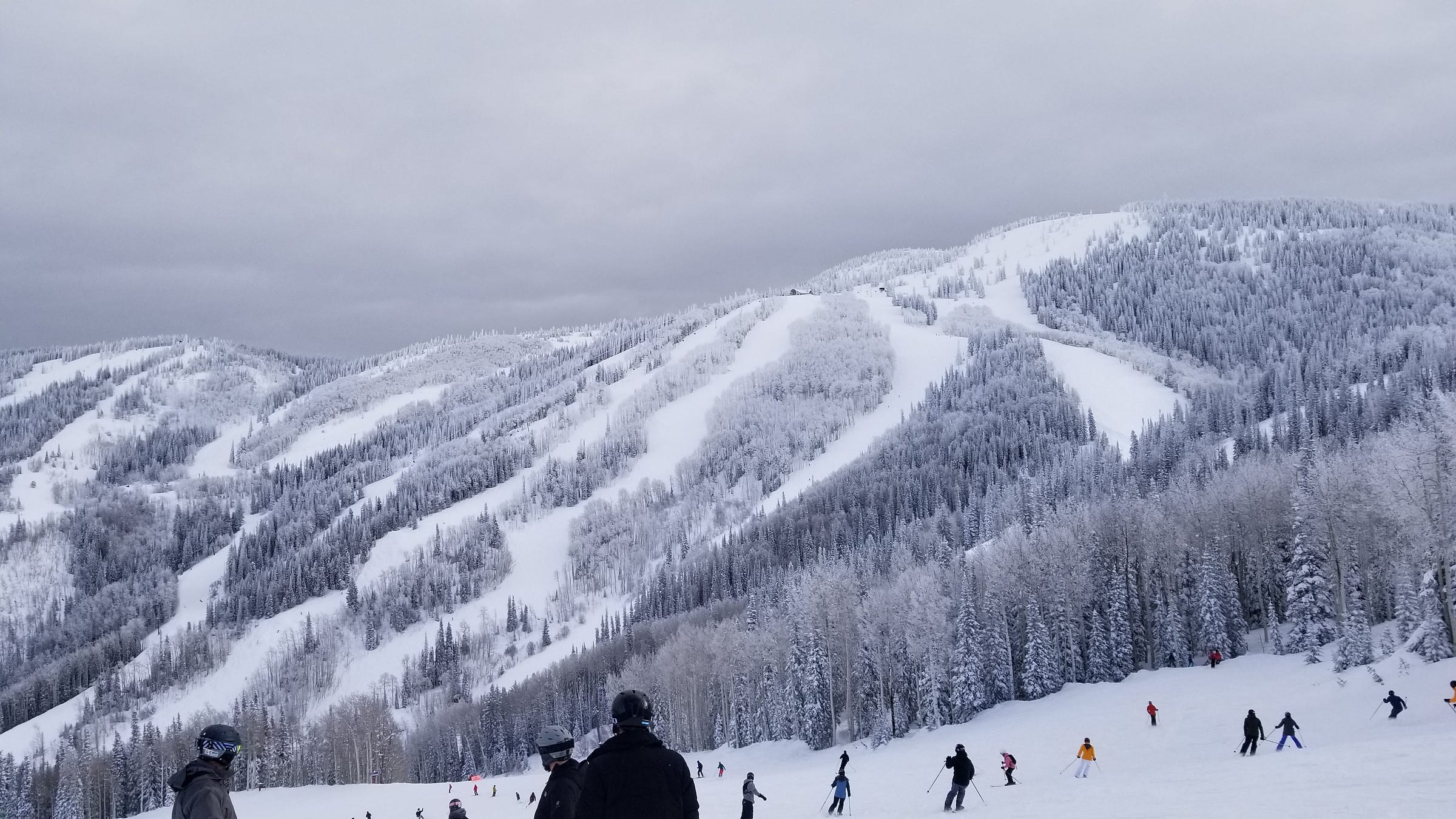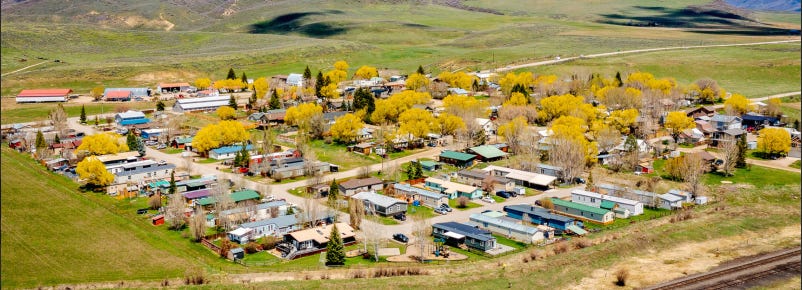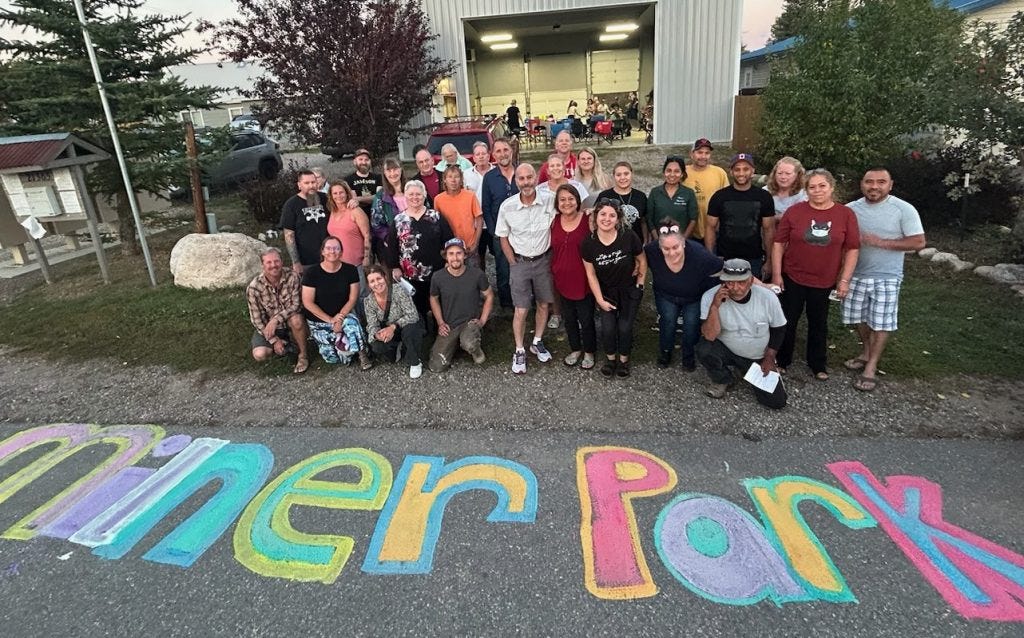Milner Park Co-op Scores Steamboat Springs Affordable Housing Win
How the sale of one Colorado mobile home park helped preserve access to affordable mountain living, in one of the state’s hottest housing markets
Alert for Readers: this coming weekend, the Quandary Magazine website will experience a brief outage while we migrate to our new domain.
We anticipate the outage will last only a few minutes. However, external links —including previous bookmarks or social media posts — may not function post-migration.
Emails will not be impacted by this change.
Welcome to picture-perfect Steamboat Springs, a Colorado mountain town known for its eponymous ski resort, trademarked Champagne Powder, and of course, soaring property prices.
This place used to be considered a bit more cowboy than country club. If you’re familiar with, you may have seen the iconic resort poster taken in front of the barn below, featuring a pair of horseback riding skiers up to their stirrups in snow.

Then came the COVID-era ZoomTown phenomenon, nearly doubling the median house price in just a few short years. Even six-figure earners found themselves elbowed out by cash offers coming in well above list price.
According to the Colorado Association of Realtors, the median sales price for a single-family home in Routt County is now $1,340,000, with an average sales price of $2,061,677. Meanwhile, townhomes and condos have a median sales price of $850,000 and an average sales price of $1,091,360.
For the overwhelming majority of the working class, this price point puts the dream of mountain living well out of reach.
And Yet…
One group of neighbors managed to notch an incredible affordable housing win in the highly sought-after region.
Melanie Stewart works at Steamboat Ski Resort. For 24 years, she’s lived in Milner Mobile Home Park, about 15 miles west of the base area.
“I was 23 when I moved to Milner. I had just graduated from college at CSU and knew that I wanted to live close to recreation and close to the things I love to do,” Stewart said. “Finding somewhere there was such a great opportunity for us to put down roots in the valley, and we loved Milner and have been able to raise our family there.”
According to Stewart, the park’s long-time owner kept lot rates reasonable. That changed in 2021 when the property was sold to an investment company in San Antonio, Texas. In the first three years, Stewart said her rent almost doubled. “It was quite a shock to us residents after having such a steady state of housing costs for so many years.”
In July of 2024, Stewart and her neighbors learned the new owners wanted to sell. Under Colorado’s Mobile Home Park Act, they had 90 days to come up with a legitimate offer before the property hit the open market.
With advice from the Yampa Valley Housing Authority and financing from the Yampa Valley Community Fund, Stewart and her neighbors were able to organize into the Milner Park Co-op, where Stewart now presides as president.
The Co-op made an initial offer of $5.7 million, which the seller countered two weeks later at $7.75 million.
“As scary as that number is, and figuring out how to make it work, we went under contract right before Thanksgiving,” Stewart said. After countless hours of work on the project, the Milner Park Co-op officially closed on the land on January 31st, 2025, securing long-term housing stability for dozens of residents, many of whom play crucial roles in the Steamboat Springs workforce.
“We have several employees from the ski resort. We have several employees from the school district, UC Health, Yampa Valley Medical Center; we have individuals, small business owners, we have a lot of tradesmen, construction workers,” Stewart listed. “Housekeepers, we have a beekeeper. Our entire neighborhood is the workforce.”
Some of these employers have recognized the struggle. In 2023, UCHealth and Yampa Valley Medical Center announced they were purchasing a 42 unit development to house employees. Steamboat Ski Resort also offers employee housing, but its dorm-like structure – sleeping two or more workers per bedroom – simply won’t work for everyone.
“I have a family. I've got two kids who are teenagers. I raised my family in Milner. So employee housing really isn't an option for me,” Stewart explained.
“I feel very honored that our neighborhood was seen and really considered to be a recipient from this fund… It's very humbling to be able to be such a recipient of an incredible gift like this, and even though it's a loan we are paying it back, it meets our needs. The donors who give to this are just really thoughtful, wonderful people.”
—Melanie Stewart, President, Milner Park Cooperative
The Affordable Housing Gap
“We're seeing a real need to step up as a community and save those places,” said Tim Wohlgenant, Chief Executive Officer of the Yampa Valley Community Foundation. He explained that properties such as Milner Park can be a tantalizing target for developers looking to plunk down another cluster of luxury condos.
“These trailer parks can be a really important backbone, providing affordable homes for people who work here, who work locally,” Wohlgenant said.
“When you talk to employers – and we talk to nonprofits all the time, nonprofit employers – they will say, and surveys show this here locally that one of the the higher reasons for people leaving their jobs is unaffordable housing, and that also becomes a challenge with just retaining and recruiting new people to fill jobs,” he explained. “So housing is on the top of everybody's list of issues.”
“Housing remains the number one concern among employers in Steamboat Springs,” said Jason Peasley, Executive Director, Yampa Valley Housing Authority. Peasley pointed to a slew of recent studies on the topic. Here are some of the highlights:
A 2023 survey by the Young Professionals Network, affiliated with the Steamboat Springs Chamber, found two-thirds of respondents were concerned about housing costs and feared they might have to leave town because of them
A 2023 Steamboat Springs School District survey of its staff found 40% of employees faced the risk of leaving the community due to a lack of affordable or available housing
A 2024 housing survey of area nonprofit organizations found more than 100 people either turned down job offers, or left their positions due to housing costs.
“Unfortunately, we have heard numerous firsthand accounts of extreme housing situations, such as multiple families sharing homes intended for one household, or three teachers splitting a one-bedroom apartment. We are also aware of people who live in their vehicles year-round. The reality is that we simply do not have enough housing available at prices our workforce can afford,” Peasley said.
This unusual inversion in the Steamboat Springs housing market – the city’s residents largely work outside of it, while its workers largely reside outside of it – causes other issues for the community.
“We're seeing an increased traffic and, definitely much more commuting from Moffet County in the city of Craig. There's 3,000 people who drive every morning and every evening back and forth from Moffat County to Steamboat,” Wohlgenant explained.
“Craig is an interesting example. Craig is not a wealthy community. It's in Moffat County. It's where there's several mines that are closing, so there's a lot of worry about the future. And yet, they see a housing problem there because most of the housing stock in Craig is quite old. And it also, it's generally larger homes than what people are looking for as entry homes, especially workforce housing.”
The Community Foundation has also helped facilitate affordable housing in Craig and Hayden, both of which are west of Milner along US Highway 40.
According to the Yampa Valley Housing Authority’s most recent estimate, the community needs another 1,400 units to meet demand.
Last year, Steamboat Springs had the opportunity to close the gap with the Brown Ranch project.
An anonymous donor gave the Housing Authority $24 million to purchase hundreds of acres of land west of the city, called Brown Ranch. The Authority drew up plans to build more than 2,000 affordable units here within 20 years.
Brown Ranch Rejection
The project was ultimately defeated in a special election. Opponents argued that annexing and developing the land would cause Steamboat Springs to grow faster than the city could handle.
“We don't usually take positions on ballot measures, but in that case we did endorse the measure, and we're sorry to see it fail,” Wohlgenant said. “I think what we as a community learned was that it was probably too big.”

“Despite the outcome of the Brown Ranch vote, the affordable housing crisis persists. The City Council has since hired Community Builders, a nonprofit organization based in Glenwood Springs to facilitate discussions and explore development options that could gain public support for the site.
“While the City is taking the lead, we are working closely with them. The outcome of the Community Builders is to have a framework annexation plan and annexation agreement in 2026.”
—Jason Peasley, Executive Director, Yampa Valley Housing Authority
When not even your doctors can afford a place to live, you don’t just have an affordable housing problem; you have a genuine threat to your community’s infrastructure.
Steamboat Springs is hardly a unique case in this regard; ski towns up and down the interstate are littered with restaurants that were forced to either slash hours, or shut down altogether due to staffing shortages during the past few years.1
As an aside — Stuart Winchester over at the Storm Skiing Journal wrote an excellent piece on the issue as it pertains to the town of Vail. You can read it here:
He is a phenomenal voice of reason in the ski industry and is absolutely worth your subscription.
The Solution
For Steamboat Springs, an affordable housing solution — defined by reducing the Yampa Valley Housing Authority’s estimated gap from 1,400 to 0 — is at least in the realm of possibility. Brown Ranch is waiting in the wings, should neighbors come around to a more gradual version of the annexation proposal.
In the interim, the newly formed Milner Park Co-op is celebrating a hard-won victory: securing a space for working class Americans to experience the mountain life dream.
“We're just surrounded by recreation. That's really why we came here originally,” Stewart said. “Gosh, it'd be hard to move here right now with the cost of living… My hope is: not only are we preserving stable, affordable housing for the people who live here now, but as our homes start to turn over and people put them for sale, it really provides an opportunity for the next person or family to have access to that.”
Thank You for Reading
For more in-depth reporting on adventure and outdoor access, consider subscribing to Quandary Magazine. You’ll get articles such as these delivered directly to your inbox. Paid subscribers get exclusive essays and resources, early delivery on select stories, and full access to our archive.
This is a widespread issue, making it difficult to cite just one source. Here are articles about the problem happening in Telluride, Summit County, Winter Park and Breckenridge, Aspen, and along the Western Slope.









